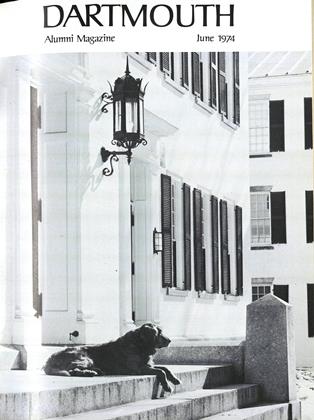SOVIET-ASIAN RELATIONS Volume 2 of SOVIET-THIRD WORLD RELATIONS.
June 1974 JOHN NELSON WASHBURN '45By Charles B. McLane '41 (Professor ofGovernment). Published by Central AsiaResearch Centre. London. Distributed byColumbia University Press. 1974. 150pp. $15.
As Communist Party General Secretary Leonid I. Brezhnev stated in his important speech August 15, 1973, in Alma-Ata, the continent of Asia, in which two-thirds of the territory of the Soviet Union is located, is currently in a state of flux. Professor McLane sets forth the chain of events, between 1955 and 1971 primarily, in Asian states comprising the so-called Third World which brought Asia as a continent to the condition indicated by the Soviet leader. Although the story is brought up only to early 1972, it is clear from Brezhnev's Alma-Ata speech in which Sino-Soviet relations bulked large that the U.S.S.R. was still as anxious to promote a system of collective security for Asia as it was in March of 1972.
The most valuable feature of the book is the new perspective brought to the important subject of Soviet-Asian relations in a Third World context. Professor McLane has provided not only a useful regional perspective per se but also a series of bilateral Soviet-Asian chronologies keyed to political, economic, and cultural happenings. These 14 individual Asian states, including the Maldive Islands, present a roughly similar pattern in the manner if not the scope of development of their relationships with the U.S.S.R. Thus, time and again, in one Asian Third World country after the other, the name of Deputy U.S.S.R. Foreign Minister Firyubin appears, most often in the mid-19605.
As Professor McLane has explained in his foreword to the three-volume series, these chronological tables "bear a heavy burden in the presentation of hard data concerning Moscow's relations with individual Third World states." They serve their purpose effectively and graphically. Of course, they cannot provide a complete insight into each intricate link in the chain of dealings; thus, the activity in the political column of Deputy Foreign Minister N.P. Firyubin is not connected with the work done on occasion in the cultural column by his spouse, the much more famous U.S.S.R. Minister of Culture Ekaterina Furtseva.
My only criticism of Soviet-Asian Relations is the author's penchant for calling the actors on the Soviet side of the Soviet-Asian relations charts "The Russians." Because the U.S.S.R. is currently enjoying its second half century as a Union of Soviet Socialist Republics, in which each of the 15 union republics has its own Minister of Foreign Affairs (for example, Sakin Begmatova. of the Kirgiz S.S.R.). it would be more accurate, even if less poetic, to term them "Soviet authorities."
Professor McLane is to be congratulated for producing the parallel perspective provided by his handy chronological tables in this as in the other two volumes of his series. He should be proud of the job he has done and of its breathtaking scale.
A former Dartmouth instructor of Russian nowwith the Department of State, Mr. Washburnholds graduate degrees from Columbia University and a law degree from the University ofMichigan.
 View Full Issue
View Full Issue
More From This Issue
-
 Feature
FeatureEducation in the Round
June 1974 By ANDREW J. NEWMAN AND MELANIE FISHER -
 Feature
FeatureChina's Barefoot Doctors
June 1974 By PETER KONG-MING NEW AND MARY LOUIE NEW -
 Feature
FeatureCASTLES ON THE CONNECTICUT
June 1974 By JAMES L. FARLEY -
 Feature
FeatureO Pioneers
June 1974 -
 Feature
FeatureRetiring Professors
June 1974 -
 Article
ArticleRetirement: Plan It and Enjoy
June 1974 By RICHARD S. BURKE '29
Books
-
 Books
BooksFACULTY PUBLICATIONS
March, 1922 -
 Books
BooksFACULTY PUBLICATIONS
December, 1923 -
 Books
BooksFACULTY NOTES
MAY 1927 -
 Books
BooksHunger: The Biology and Politics of Starvation
July/August 2011 -
 Books
BooksHEAVEN ON EARTH
June 1940 By Lewis D. Stilwell -
 Books
BooksTHE COMMAND OF THE HOWE BROTHERS DURING THE AMERICAN REVOLUTION
June 1936 By Wayne E. Stevens

